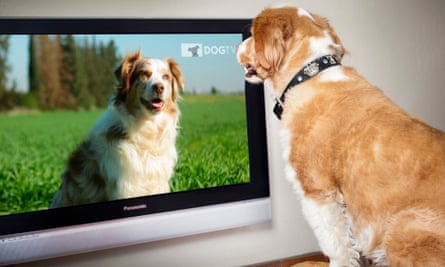“We had some cats, but we found out that dogs do not react well to cats. So there are no cats on DogTV any more,” says Ron Levi, midway through explaining the origin story of the world’s first TV channel for dogs.
The Guardian’s product and service reviews are independent and are in no way influenced by any advertiser or commercial initiative. We will earn a commission from the retailer if you buy something through an affiliate link. Learn more.
For dogs. Not about dogs – although there are plenty of canines on-screen – but a channel designed for dogs to watch, usually (but not exclusively) when their owners are out of the house.
To many non dog-owners, it may sound like a joke. To many dog owners, especially those who’ve had furniture, shoes and/or fridge-fulls of food chewed by a stressed-out animal home alone, the idea has (four) legs.
DogTV isn’t a joke. Launched in Israel in 2009, it now has TV distribution deals in nine countries; is reaching a global audience through YouTube and its own apps; has “millions, maybe tens of millions” of viewers, and is part-owned by TV giant Discovery Communications.
No cats, though, even if the original launch was inspired by a feline: a British cat called Charlie that Levi took with him when moving from the UK back to Tel Aviv.
“I had this idea in 2007. Charlie used to stay at home alone every day, and give me the saddest eyes in the world when I came home, making me feel so guilty,” he says.
“I downloaded some stuff from the net – videos of birds and squirrels and fish – and he just reacted amazingly. And it made me realise we can use the TV to help these animals that are depressed and bored.”
According to Levi, DogTV’s initial research showed that 57% of Americans already left their TV on at home during the day for their pets, but that even channels like Animal Planet weren’t really suitable for a four-legged audience.
“There are a lot of commercials, a lot of different sound levels, a lot of talking,” he says. “A lot of crocodiles that can scare your pet. These channels were not designed for animals.”
Thus: DogTV. Not CatTV, despite Charlie inspiring the idea. “We thought that there was a real need with dogs: people feel really guilty leaving their dogs at home,” he says. “Most cats are like ‘you go to work, I’ll be fine! I’ll take care of this palace…’.”
Levi stresses the science behind DogTV’s content, with its shows grouped into three categories: Stimulation, Relaxation and Exposure. The first to stimulate dogs’ brains, the second to chill them out, and the third to expose them (gently) to things they may find frightening in the real world, from fireworks and traffic to vacuum cleaners.
“We spent our first three years researching, learning about dog vision and hearing: studies on areas like colours and sound frequencies. Then we produced two hours of content and tested it in a study in LA and New York, where we built security cameras into 38 apartments and monitored dogs watching TV,” he says.
Hence the lesson that cats weren’t a hit with the target audience. “But also that dogs don’t respond too well to barking sounds. We had a lot of them at first, and some dogs got irritated and started to bark. So we took that out,” says Levi.
In some countries, DogTV is a subscription-based channel – $5 a month in the US, for example – while in others it’s free. Levi says it has subscribers from 35 different countries, but prefers not to reveal how many.
“We’re available to 60m eyeballs around the world, but some of our new platforms aren’t even subscription. It’s a little shift from subscribers to users, if you will. We have millions or tens of millions of users, and we see the broader picture. So many people are discovering DogTV on different platforms: we’re free on YouTube and we have millions of views,” he says.
Levi says that he’s relaxed about DogTV being treated as a gimmick in some quarters, before listing a series of reasons why it should be taken seriously.
They include science – “three years of research and 60 different studies from universities” – as well as its “dream team” of four dog experts, including British dog trainer Victoria Stilwell, of It’s Me Or the Dog TV fame.
Also patents. “We patented all the content. We have 11 different patents, which is huge. The colours that we have that are very specific to dog-vision, the sound frequencies, the music … it’s all patented,” says Levi, who also says that DogTV continues to refine its art over time.
“Normally with music and visual content, people try to do more: another cut, another camera angle to make it more interesting. With dogs, it’s the opposite, you have to do less,” he explains.
“If you do more, you’re going to lose your audience. Another cut, and the dog is ‘where did that go?’ and you’ve lost them. They have brains like two-year old kids: if you do another camera angle suddenly or go point-of-view, you’ve lost the dog. You lose your audience, and they get irritated.”

What about the future? More TV deals in more countries, and the growth of DogTV’s digital channels on YouTube and through its apps for mobile devices and connected TVs. “That’s the biggest thing internationally: to bring this to as many dogs in the world as possible,” says Levi.
What about cats? Charlie and his sad eyes ...
“We get asked about cats every day! We get so many cats already watching the channel. There are some people with parrots who have subscribed. I’m not sure you’re going to see a ParrotTV or a FishTV, but CatTV makes sense. But for now, we are focusing on the dogs.”
And their owners. In the US, DogTV has picked up on a trend for people to watch its channel with their pets, and started airing a few shows designed for co-viewing. There’s even a show called Dogstar, which is (sadly) nothing to do with Keanu Reeves’ now-defunct rock band, but is instead a show for viewers to send in videos of their own dogs.
Levi is optimistic. “Every year I see less and less cynicism, and more people not just knowing about DogTV, but understanding DogTV as not a joke or a gimmick, but as a real thing that can help dogs feel more relaxed,” he says.
Levi claims that DogTV regularly hears from viewers whose dogs were on medication for separation anxiety, but have come off the drugs since their owners subscribed to the channel.
“Dogs get bored. Dogs are bored being home alone all day doing nothing. We don’t expect them to sit being a couch potato all day, but we’re giving them something in the background to help them be less depressed or stressed,” he says. “If we can help there, then we’ll have really achieved something.”

Comments (…)
Sign in or create your Guardian account to join the discussion